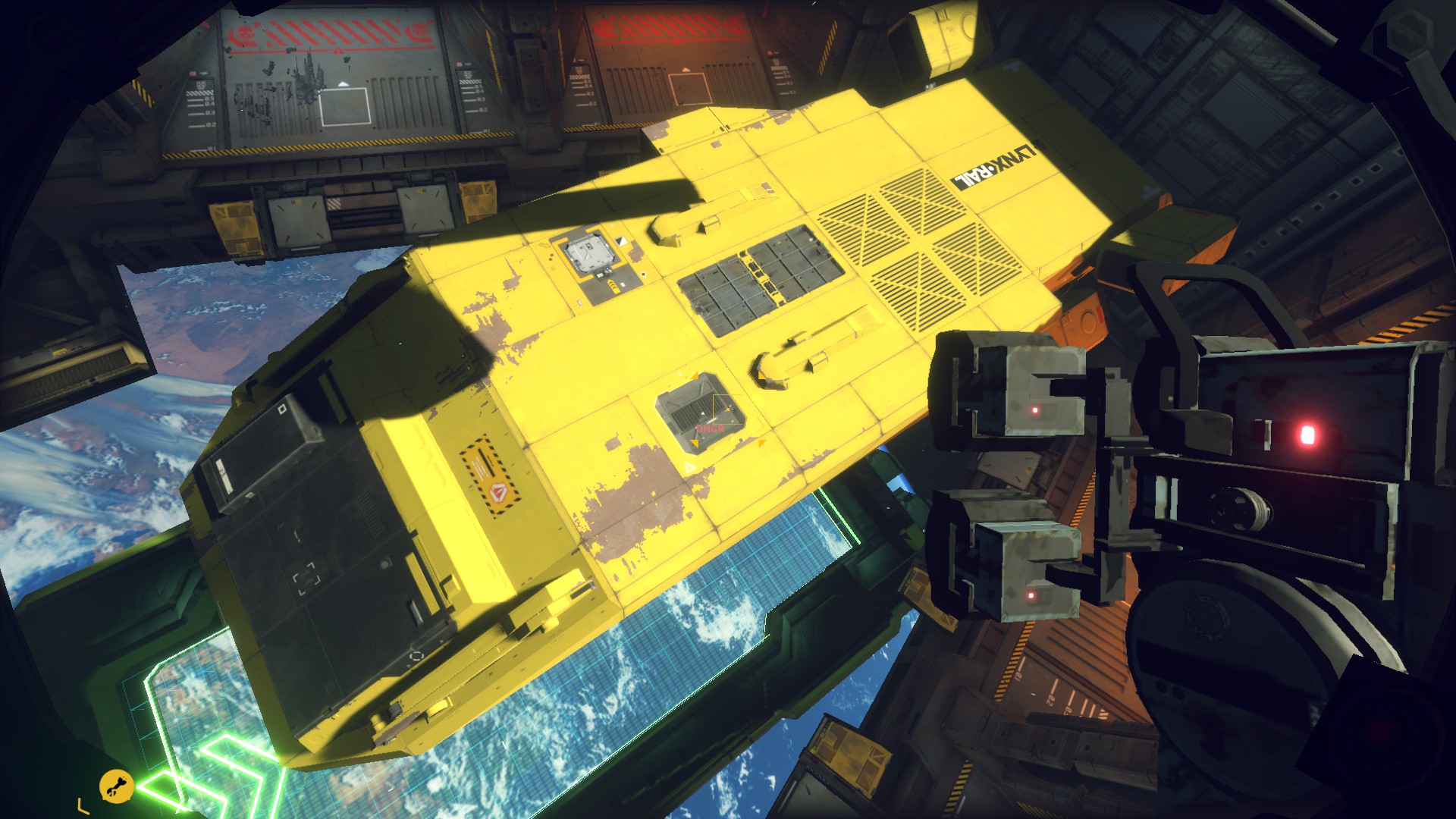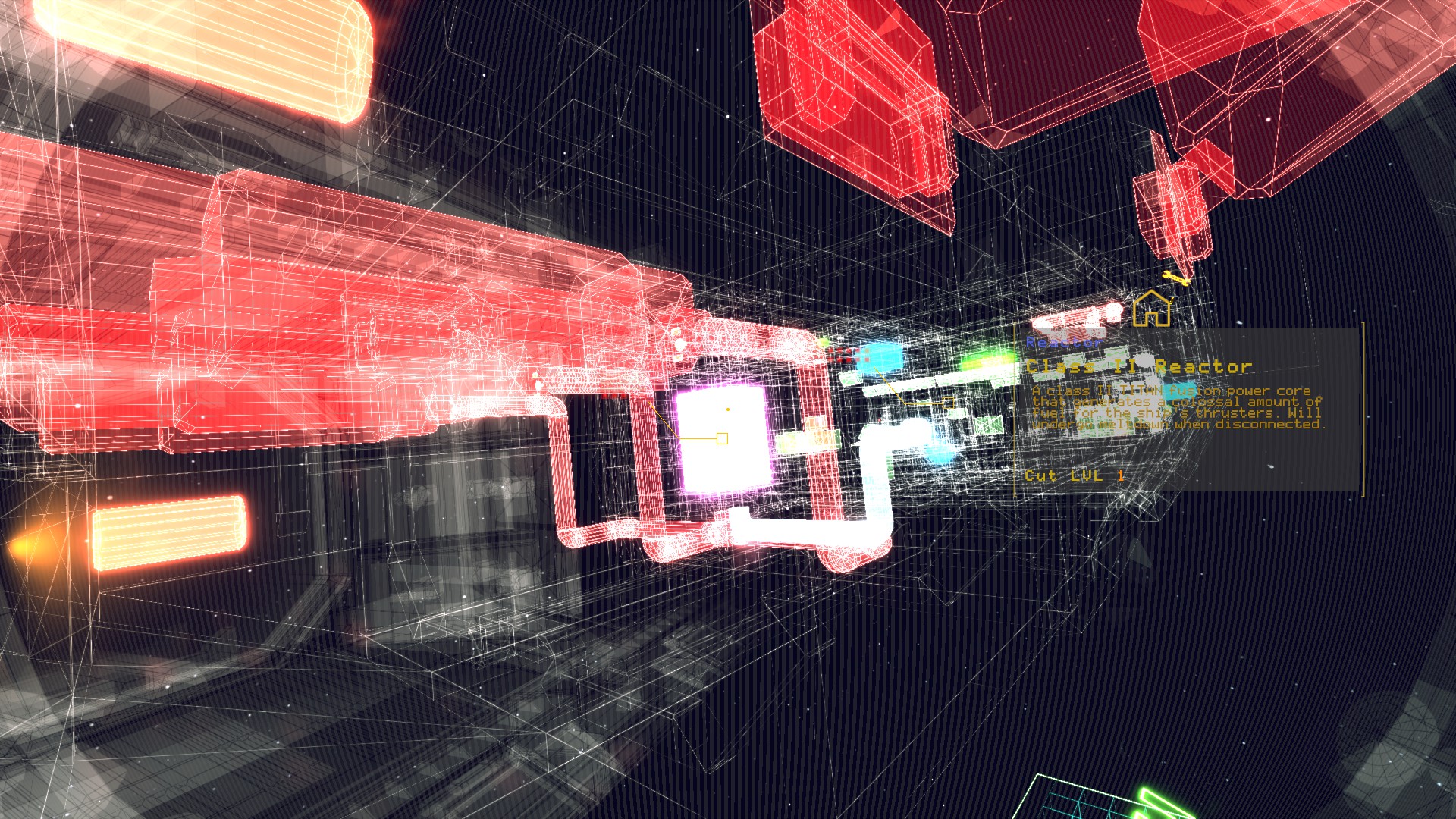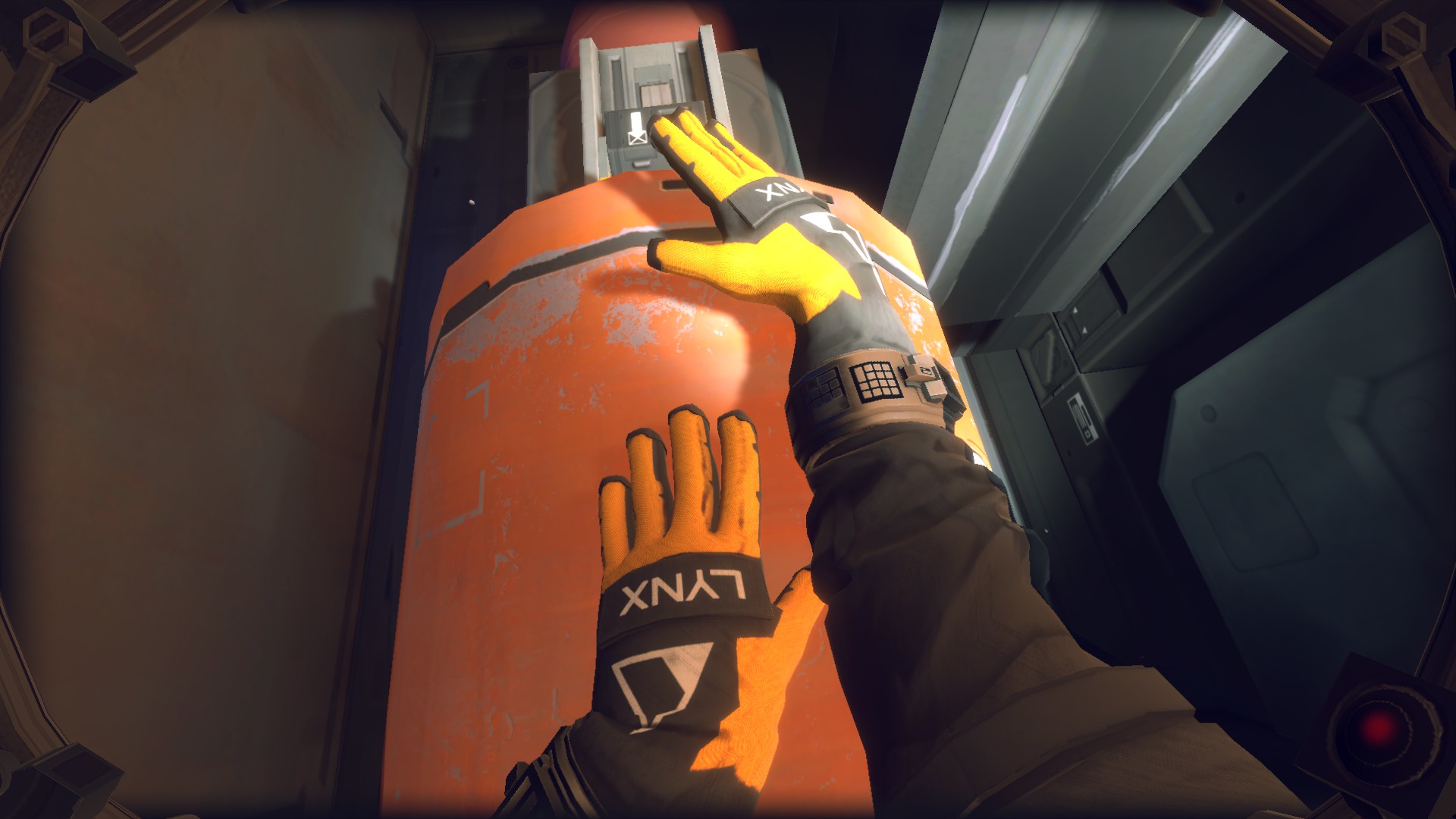The basic idea is that you fly around disused spaceships and gradually cut them apart for scrap and salvage, in a full 3D simulation complete with deadly hazards, time and money pressure, and a soothing space banjo soundtrack. It is lovely. And after playing it regularly for over a week, I’ve found some less obvious reasons why it has made a home in my heart. It’s the details, mostly. But what details.
1) The state of the ships
Shipbreaker’s setting is great, its physics very impressive indeed, and its whole premise both original and well executed. But there’s no doubt that the ships are the star. I hope we’ll see loads more models during its remaining year or so in early access, because the existing ones are excellent. The designs are neat and all, but I love the amount of completely unnecessary detail that’s gone into them. You would not believe how excited I got at merely seeing a usually grey ship turn up in bright yellow instead. I was chatting to Imogen and Astrid (RPS In Peace) at the time and I can’t even remember if I interrupted them, because I was so busy loudly saying “Yellow ship. YELLOW SHIP! LOOK AT THE YELLOW AHHH”. But it’s not just that it was yellow. It’s that it looked so loved, too. Patches of the paint were worn away. Inside, junk food cartons floated around, posters adorned a computer room (you can even salvage them), and in the belly of the ship with all the engines and that, panels of metal had little scratches and dings and divots in. There’s no need for any of this. And then I went to the engine room, which overlooked the hefty class II reactor through a window. And just look at the state of that window. You just know the crew cleaned that window regularly, but it still somehow got like that within a day or two. I’d love to see more of the ’lived in’ look in time, perhaps even ships with custom layouts the crew have bolted on while living out in deep space. Unlikely crew quarters, a disused cargo bay converted to a games room. These ships are made with love, and I want to see more of them.
2) The pink and black scanner mode
I don’t make extensive use of the scanner. I consistently use it to check for hazards before cutting, but not for its main use of mapping out the ship. I like to see all that first hand. To touch it, even. But that doesn’t mean I don’t sometimes switch the scanner on just to enjoy a change of scenery. As you play Hardspace Colon Shipbreaker, you earn points for completing work orders. These are spent on upgrading your tools, or even buying your own equipment to save on long term rental. The scanner starts with one basic mode, which highlights the structural girders and joints of a vessel in orange, and different hull materials in blues. Strictly speaking this is all you need, since hazards like pipes and engines are visible through walls here too. But upgrading your scanner offers more vision modes. One highlights equipment like batteries and engines, another more niche electrical items. There might even be more; I’ve not unlocked everything yet. I like the third one because it’s pretty. Blue and orange is practical, functional, perfectly fine. The second mode is a distasteful mustardy thing. But the vivid pink and black of the electrical thingy mode? That’s a spectrum that would make a Predator weep.
3) Weaver
Is Weaver his name, or his job? The player is referred to simply as “Cutter”, suggesting the latter. But I think it’s both. Weaver is your shift supervisor. There’s also someone who acknowledges your salvage contributions and criticises you if you blow something up, but my suspicion is they’re from an admin department, and not technically your superior. Their occasional passive aggressive notes suggest to me that their solidarity would be questionable should you ever take industrial or direct action against management, and… well, anyway. Weaver. Once the tutorials are out of the way, Weaver pipes in only at appointed times, to remind you that the shift is drawing to a close. He is nonetheless warm, his gentle American drawl (with a refreshing Canadian phrase or two sprinkled in) cancelling out what might otherwise be an annoying intrusion. But what I love is how much he does to establish this as a real job. Far more than the shifts and targets and debts, Weaver sells salvaging as a real activity. He’s a convincing voice of the worker, and through him Shipbreaker recreates the cursed camaraderie that makes drudgerous jobs tolerable. And in doing so perpetuates their injustices, so you end up staying for far longer than you should out of misplaced loyalty to the other victims, or god help you, to the shop/warehouse/restaurant/etc. itself. We have all been Cutter or Weaver. Well, unless you’re too posh to have ever done a real job. Weaver is almost definitely a company man at heart. You’d have to be to last that long. But then… who knows? Maybe he’s stuck around because….
4) The dystopia is less horrible than reality
On the face of it, this is a terrible existence. You’re indentured to a powerful, possibly omnipresent megacorporation, with a monstrous billion dollar “debt”, charged another 500,000 just to exist, and to rent your own working equipment (which can explode in your face) for another 15 minute shift. You pay for oxygen, you pay for fuel, you pay for repairs. The job is highly dangerous, and even death won’t release you from it, since the company will resurrent you, for another debt. You are effectively penalised for doing a thorough job rather than hitting your targets and then clocking out. When you run out of oxygen and start to die, a recording chides you for risking damage to company equipment. And yet… I can make this work. I’ve paid 1.6% of my debt off, and a significant chunk of that was from one ship. And I’m not prioritising the debt, either, I’m concentrating on recycling as much material as possible. I’m a terrible person, willingly enabling my own exploitation out of a sense of civic duty and professional pride. In real life I would look down on my Cutter with open scorn. But in game, this is doable. The debt is so comically vast that fretting over spending or inefficiency is pointless. As long as I’m making some progress, that’s okay. I’m getting access to bigger ships. I’m finding ways to reduce my expenses. Mathematically, I can pay off a billion dollars (really far more, given the interest and rental fees) in Hardspace in a thousandth of the time I could pay off a few thousand pounds in real life.
5) The Gurgle
Most ships have a fuel line. In the simplest of ships, fuel pods are fixed directly next to the engines, so there’s no real problem. But others have a pipe running the length of the ship, and the larger ship (there are currently only two main ship designs, although their innards feature several variations) has several, winding about in three dimensions. You’ll want to reclaim those pipes if possible, cutting them up into manageable pieces, or even dissolving them to clear a path for that big expensive reactor. First you’ll want to flush the fuel from them, and you can do that by buying or finding single-use keys, for uses in an engine console. Or you can find the manual valves and give them a satisfying pull (make sure to do it in the right order, or you risk leaking their alarming purple plasma everywhere). The larger ship has a coolant pipe to think about too, which is a whole other problem. The pipes tend to have lights on that indicate when there’s fuel inside. But that’s boring. The fun way to test the pipes is to put your hand on them. Press the X or Z buttons and you’ll reach out with either hand, and press it against the pipe. If there’s fluid moving inside, you’ll hear a wonderful gurgling sound. This is almost entirely redundant and I love it even more for that. And speaking of hands….
6) You can “be” Spiderman
I play with the HUD off. A tiny bit to show off, but mostly just because I can, and although it could use a few tweaks, it mostly works. One reason I like doing this is because it makes it much more likely that I’ll run out of thruster fuel. Why would I want to do that? Because I’m awkward, obviously. But also because if you run out of fuel, (a) you might be caught in mid-air, floating towards a furnace, dumbly hitting the movement buttons for several precious seconds before realising what’s happened, and (b) the only way to move without your thrusters is pulling yourself around with your hands. Your gloves will attach to any solid surface. They’re actually quite handy when you’re in a tight crawlspace and need to stay still while cutting some joints around a hazard like the fuel pods or coolant tanks. Just hold the Z button and you’ll attach to a nearby space, and can hang off it while aiming your torch or split saw with the other hand. Like a show off. They’re handy too for manoeuvring the long storage boxes from a cockpit’s awkwardly narrow doorway - just hold the end and wiggle around a bit to pull it out lengthways in a way your grapple gun can’t manage. But the best part is when you learn to cycle from hand to hand. Stuck inside the backstage part of a gecko? Just nimbly climb out, skilfully hauling yourself along walls, floors, pipes, armour, and whatever random girders or armour chunks you’ve left floating around. That’s why they’re called crawlspaces, right? And if you must get back to your starting barge, well sure you could use the tertiary function of your grappling hook. But the fun way is to spider-walk the length of the ship for a run-up before launching yourself off into space, hoping for the best. Honestly, it’s not really surprising that….
7) The only real danger is you
I have not yet died. I have been injured by a coolant leak (I’m still not sure how, and insist it must therefore have been a manufacturing fault or a microtear in the tank, or… look, I know what I’m doing damn it. These ships are decommissioned, don’t tell me they’re never to blame). I get non-fatally electrocuted about once every five shifts. I have briefly caught fire twice, thanks to my overheating torch. And whose fault is that? Well, it’s mine. I got distracted talking, and didn’t pause for long enough between cuts. I’ve no excuse. There’s a temperature bar right on the side of it, even when you have the HUD switched off (itself a candidate for a Best Thing About). And that’s why it’s not fuel pipes, decompression, or a reactor in meltdown that’s dangerous in Shipbreaker. Just as with real life de/construction work, the only real dangers are rushing and complacency. Well, and inexperience, but that goes away. This is key to why, despite how divisive they are and will likely remain, the shift timers are really important. They will make you impatient. You will hurry to yank out something nearby to make use of the declining seconds. You’ll rush a cutting job so you can get that final fuel pod out without having to pay for another shift. And especially with cutting, the temptation to be complacent is always there. Why scan behind this panel just because I’ve changed position? It’s fine. And that’s when you pierce a fuel line, or cut the edge of the thruster cap, costing yourself easy money, and worse, looking like a cowboy in front of Weaver. He says nothing. But he thinks it. Oh, you know he thinks it. And that’s why we have building regulations, kids. 99% of the time they’re an annoying chore. Bad workmen get in the habit of breaking them because it’s usually fine. And then they break a sealed cockpit and the change in pressure sends a 4m² metal panel edge-first through their ankles. The company doesn’t have your back, cutter. You gotta watch yourself out there. Have some standards. Measure twice.









